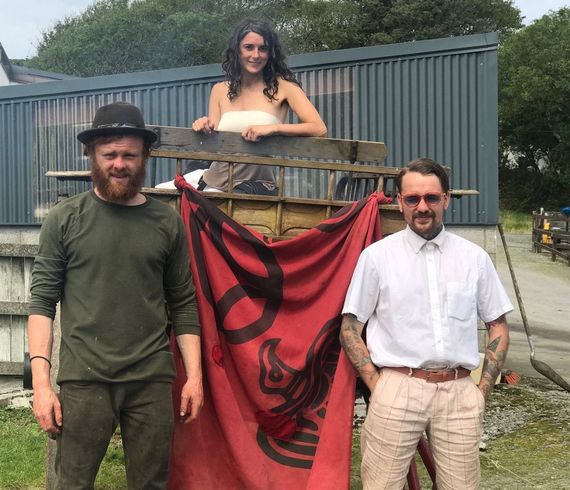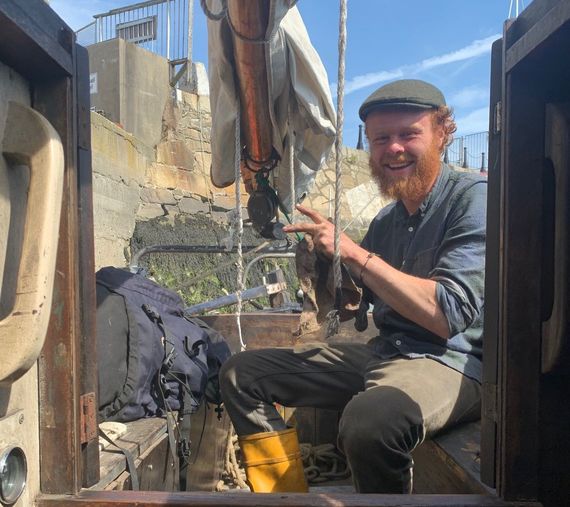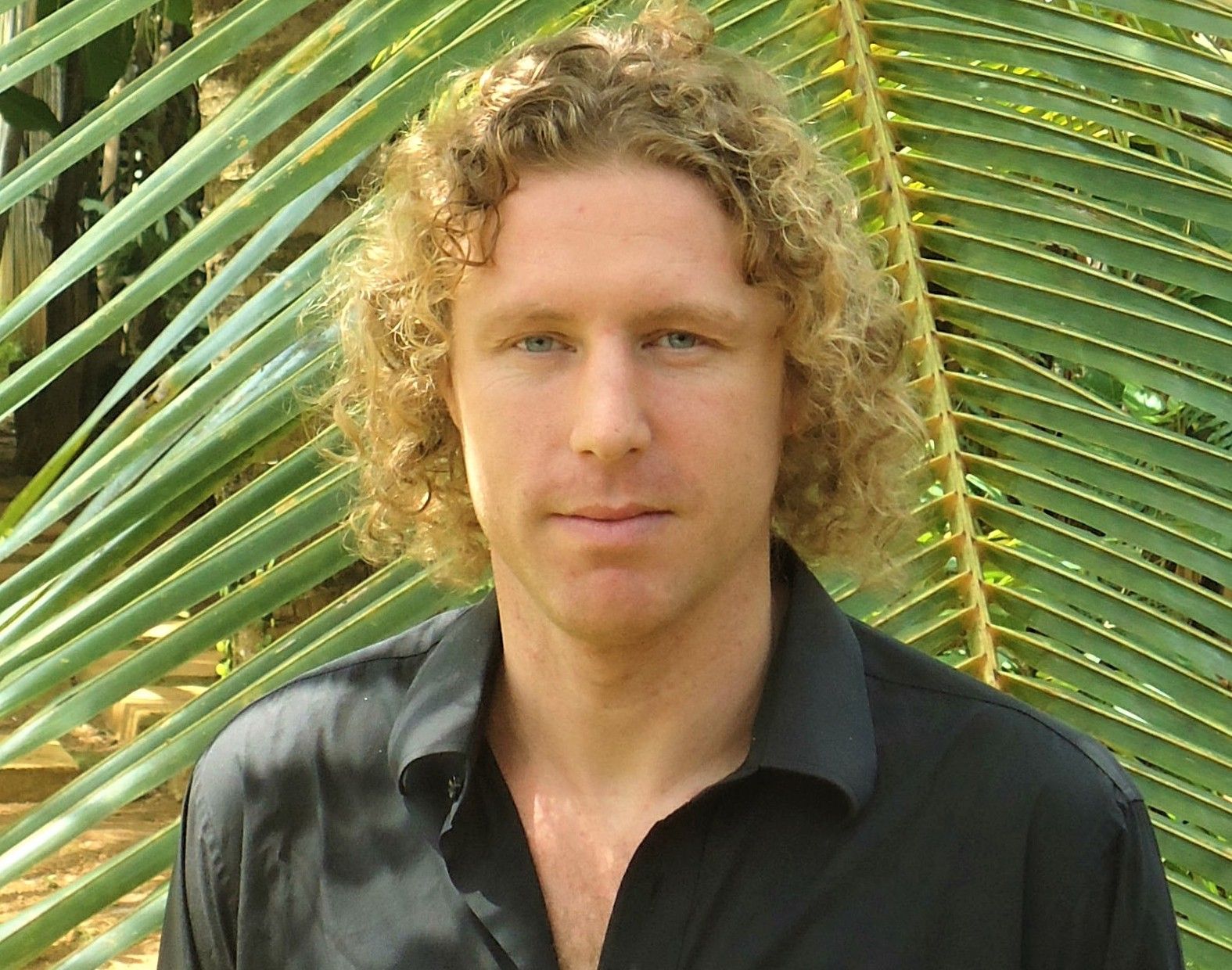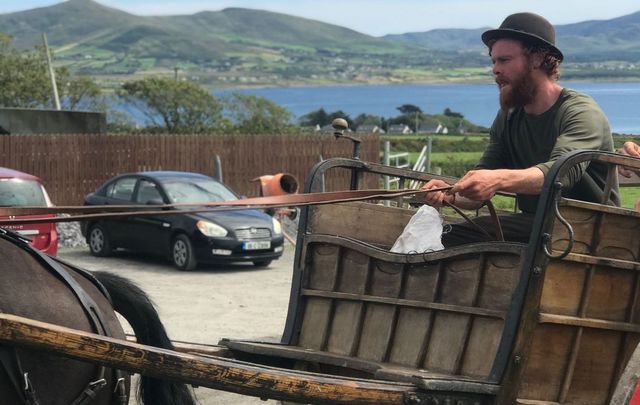From an ancient stone circle in Norway to a Neolithic ceremonial and burial site, one man's mystical mission to rebalance Ireland’s natural energy by carrying a fire of abundant life back home.
The Atlantic wind off Ballyheigue Beach in north Kerry rushes up the golf fairway, whooshes through the flames, and blows smoke into Darragh Carroll’s pelt of scarlet beard that stretches ear to ear beneath his brown felt hat.
‘We’re cooking up a storm in the castle,’ the 26-year-old Dublin chef arranges the large pot of broccoli and peas to make space for the two-foot wild salmon donated by the locals. He’s tall, and the elements have him worn older and wiser-looking than his years, but he moves with the flickering ease of a flame.
A dozen Ballyheigue residents surround him to observe the feast cooking in a manner not seen here in decades. This evening’s banquet is being prepared on the sacred fire, currently sitting on an iron pan atop three short legs.
Darragh first sparked the mystic fire at an ancient stone circle in Norway and has carried the Norse flame over land and sea keeping it burning continuously for almost a year. Meditating one night at the Norse pagan site, Darragh received a vision which was later interpreted to mission by a Viking druid: to rebalance Ireland’s natural energy by carrying a fire of abundant life from Norway to the Hill of Uisneach in Co. Westmeath, a Neolithic ceremonial and burial site considered the mythological and sacred heart of Ireland.
After nine months alone in the North Sea, Darragh brought the fire to ground only to find Ireland suffering from the disconnection and confusion created by the COVID pandemic. Inspired by his quest, a small crew of fire-keepers and chefs joined Darragh to assist with the second leg of his journey - transporting the Norse flame by horse and trap across the country.
Darragh and his band follow no set route to Ireland’s central point, leaving it to the generosity of the people who cross their path – in return for a field to pitch their tents they’ll cook up a feast - using the fire to help restore hope through community and connection. Tonight the owner of the Ballyheigue Castle Golf Club invited the crew, their old horse and cart, and the fire, to make camp and cook for the people of the seaside town.

The keepers of the flame.
At the entrance to the golf course, beneath the ruins of the old Crosby castle – used as a prison during the War of Independence and subsequently burnt-out by the locals – Ballyheigue residents wait for their dinner, careful to keep two-meters apart.
Observing the scene, Lady Captain of the golf club, 59-year-old Mary O’ Halloran says: "I haven’t seen anything like this in years – on the long summer nights when I was young girl we would cook our tea over the turf fire before getting back to work on the bog."
Darragh plans to extinguish the fire at a ceremony at Uisneach on October 31st, Samhain – Ireland’s traditional fire festival celebrating the end of the harvest season. This ancient pagan religious holiday also marks the beginning of winter – the dark half of the year.
Divvying up the salmon, Darragh says: "This year Ireland will need all the light she can get."
From the feverish kitchens of Dublin to traveling the world as a chef in Canada, Mexico, and even a stint in a Michelin-starred restaurant, Darragh wondered how he could combine his two great passions: cooking and being in nature.
The start of the journey
Long fascinated with Ireland’s ancient heritage and especially gypsy culture, a seed sprouted and began to grow – a dream to one day travel around Ireland in a bow-top gypsy wagon customized as an open-kitchen, to: ‘Bring people out into nature, offer them wild cooking, and give them wild experiences.’ Darragh invested his savings in an old horse providentially named, Samfire, along with a classic 19th-century French cart. Then an offer came to cook in a friend’s restaurant in Norway.
The barn-house style restaurant on the Norwegian island of Tramoya sourced most of its produce locally. Spending his free-time fishing; foraging mushrooms, berries, and herbs; as well as diving for mussels and oysters, he knew this was the perfect training to prepare him for ‘wild cooking’.
He was also attracted to the island for its old-growth oak forests and an abundance of nature Darragh reckons modern Ireland desperately lacks.
Read more
Spending a lot of time alone in the primeval forests Darragh discovered an ancient stone circle and other features of Norway’s pagan past. In the Viking spiritual site, he meditating regularly on the fire and the same vision returned time and time again: ‘The spirit of the fire – a spirit of balance in an eco-system, and within life itself – can be carried and transplanted to a place of need.’ Darragh’s vision instructed: ‘Go to the heart of Ireland to create an impulse of fertility that will spread from the heart out.’
Given the absurdity of the mission Darragh tried to dismiss it telling himself, ‘You can’t be walking from Norway to Ireland with a fire… That will take years.’ But the notion wouldn’t leave him be.
Irish and Viking history
A keen student of Irish and Norse mythology, Darragh became increasingly aware of the old pagan stone carvings dotted all over the island, these now seemed to reveal the same message. He persisted in dismissing it all as ‘a bit mad’, but the more he tried to ignore it, the more the idea pursued.
Seeking evidence to support his vision, Darragh researched ancient links between Norway and Ireland and discovered our Neolithic archaeological sites have much in common, suggesting cultural and spiritual connections far predating the Vikings. He also found that the Vikings who came and settled in Ireland were predominantly from modern-day Norway. And that even the names: Ulster, Munster, and Leinster, as well as the word ‘Ireland’ itself, are partially derived from the old Norse language. These age-old connections bolstered Darragh’s growing faith in his own intuition, gradually making the quest a real possibility.
To the other part of the puzzle; how to transport the fire? The island provided the answer.
"Tramoya has a strong history of Vikings – Norway’s sea gypsies," Darragh says. "Everyone I was coming into contact with was talking about some form of ancestral teachings or of sailing and old wooden boats."
"You’ll make it to Ireland on this boat," the mouth on the Viking druid was a patchwork of gold and broken teeth. "She has a good engine."
Darragh looked at the traditional Norwegian sailing boat a hundred years old if it was a day. Into the bargain, it was called the Ran – the Norse Goddess of storms and the drowned dead. It’s like naming your boat the Titanic, Darragh thought.
Sitting alone on the harbor one day, the Ran had docked and the Viking invited Darragh to his home 30 miles down the coast. There the druid lit a fire at another stone circle behind his house and for the first time, Darragh spoke about his vision.
The fire glinted off the old mystic’s gold hoop earrings, then with doubtless gas-blue eyes he insisted: "You have to do this."
Willing and open to his quest, Darragh’s connection to the fire strengthened and he now experienced it as a wise, old grandfather – eternal, universal energy pulsing in a healthy eco-system. He believed this grandfather spirit was now offering him the different elements he needed for his journey. Darragh’s previous sailing experience was limited to tourist day-trips in the Gulf of Mexico, yet his gut told him this quest was his destiny.
Over the following days, he and the Viking prepared the battered old Ran for the biggest voyage of her long and leaky life, finally loading the boat with the fire in a newly-fitted stove and hardwood ideal for keeping the sacred flame alive throughout a long journey.
Preparing for the voyage
Darragh recalls, "Even though both of us were going for the whole idea, we were also aware this could end really, really badly."
Winter temperatures in the North Sea hover just above freezing, are exasperated by the wet and windy conditions, and the whole situation is generally not improved by each day’s nineteen hours of darkness. But sensing these elemental forces would energize the fire, Darragh left immediately.
Considering his mother and father, a hairdresser, and a postman in the quiet Dublin suburb of Rathfarnham, Darragh thought: "They’re not going to like this for Christmas." So he told them he would be spending the holiday in Switzerland.
On November 15, 2019, in a boat usually manned by three, Darragh cast off alone to face the North Sea. Darragh firmly believed if he protected the fire it would keep him safe.
Darragh onboard The Ran.
From Tromoya, off southeast Norway, Darragh followed the coastline north-west to the port of Hugueasund. From there he aimed west to cover the 220 miles to the Shetland Islands.
"The first day I got completely smashed," Darragh says. "Seven hours out and the sea came right up. Some of those waves brought half a ton of water into the boat in an instant. Three of those and the boat is very, very heavy. I’m bailing out the boat with buckets because the battery snapped from its frame and landed in the engine, blending the battery… And if you have no electric pumps running underneath… then you’re sinking."
Then the stove chimney was knocked loose so an open fire choked the cabin with thick smoke leaving Darragh coughing and vomiting while trying to bail water as the waves continued their assault. All the while desperately aware he had to make it back to port before the engine gave out or he would be in serious trouble.
Back at Hugueasund, the poor Ran was in a bad way – broken mast, a crack in the deck and tiller, battery and radio destroyed. Darragh wasn’t doing a whole lot better, shaken, and despondent he sat on the fractured deck. Day one and the North Sea had revealed the mortal danger his mission entailed. "Not only did I come up with a bad idea, but now I’ve failed. I’m in Norway with a smashed up old boat and winter coming in, and I’m there with a fire…" Darragh recalls, asking: "Do I sell the boat, cancel the fire, and go home for Christmas? Or keep going?"
Letting go and carrying on
At that moment a stranger appeared asking about the old sailing boat – a mechanic, electrician, and carpenter who had lived on boats for 20 years. "Give me three weeks and you’ll be ready," the stranger offered.
"Oh no, I’m going to have do this again?" was Darragh’s first reaction. But he was beginning to understand how the fire operated – attracting the ideal stranger at the perfect moment – it was all a test to see if he had the resolve to take the journey no matter what: to accept he might not make it home, or even live to tell the tale.
"Letting go to that was a big leap," Darragh remembers. "But once I done it, all the weight of fear fell off my back."
On December 10 2019 Darragh set sail for the Shetland’s a second time. The voyage took three days, and then he continued a further 100 miles south-west to the Orkney Islands. Weather permitting, he planned to cover the final 76 miles to the inauspiciously named, Cape Wrath - the most north-westerly point in mainland Scotland. But Storm Brendan had other plans.

Darragh onboard The Ran.
"The wind was insane," Darragh remembers. Eighty mile-per-hour gales ripped over waves up to forty-feet tall tossing the little Ran and its lone sailor around like driftwood, almost sinking the pair and their precious cargo more than once. But below deck the fire blazed – as if invigorated by the elements - and Darragh had no fear: "I had full confidence in the fire."
Surrendering to the power of nature, Darragh headed towards the relative shelter of Lough Eriboll – a nearby sea-loch long used as a deep-water anchorage for sailors escaping the cape’s wrath - only to discover the Ran dangerously low on fuel which forced him to use his sail to negotiate the tempest.
Lough Eriboll proved not to be the vital port in a storm Darragh had envisioned. Vicious winds wrenched the anchor clean out of the water forcing him instead to attempt banking the vessel on an adjacent beach. But thirty yards from shore, overwhelmed by a floodtide and hurricane-force winds, he lost control, and the Ran capsized.
Shipwrecked
‘I started to do everything I could to keep the water out but it just was filling too fast,’ Darragh said at the time. Shipwrecked, Darragh gave the fire a feed of hardwood before forsaking the Ran. "I decided to abandon it, so I put on a survival suit, jumped into the water, and swam the 20 meters to shore."
The police and some locals brought Darragh food. Then, over a 14-hour campaign amid raging gales and torrential downpours, they helped him and the coastguard haul the old vessel from the freezing waters.
Afterward, Darragh said: "It was incredibly inspiring to see such helpful, hard-working locals willing to stand in the rain from morning to night to help me."
This was mid-January. The Ran was recovered but needed a lot of work if Darragh was to complete his mission. Living on-board the grounded vessel, and picking periwinkles to earn money, the repairs would take two months in the dead of winter in the harshest region of the Scottish Highlands.
"The hardest part was the mornings when your clothes got wet," Darragh recalls, "out fixing the boat with tar and it’s really, really cold." But again the Norse flame saved him. "The fire on a wooden boat keeps all your clothes dry. It keeps the boat dry; it keeps your blankets warm; your food hot and the tea on. So without a fire constantly going I never would have made it."
Only as his journey progressed did Darragh understand his inter-dependence with the fire: "It kept me going. The fire is the heart. I set off just with the ambition to carry the fire. I didn’t know the intuitive teachings of it, or what it would bring about along the way. Every day I’m learning more and more about the balance of the fire."
Read more
"And in the community, you see how it affects other people, how keeping a fire alive is quite inspiring," Darragh says. Hearing his story, the locals labeled Darragh ‘stone mad,’ and that’s really saying something in the Highlands, but they respected his hardiness and supported his ‘mad’ quest every way they could.
Yet, nothing could be done for the Ran’s flooded engine. Darragh was now faced with completing his sea-journey from northern Scotland to the East Coast of Ireland on wind power alone. He wanted to give up. What else could go wrong?
Then Coronavirus infected the planet. "I was down in spirit; the boat was on the rocks… But when COVID came in, that was a light for me to keep going." Darragh felt he understood the deeper meaning of his quest – up until now the fire was teaching him, helping him grow strong – but to respect the symbiotic relationship he had to pass on the fire’s teachings.
So he stocked up on supplies – especially hardwood, food for his companion – and prepared for the slow crossing: "I knew when the boat went down this was a test of strength - that if I could make it out of this situation then I would be honourable enough to carry such an ancient spirit to where it needs to be."
Sailing home taught Darragh patience. Bad luck with the winds, and a whole new world of lockdowns, quarantines, and closed ports, meant it would be four more months before he could finally bring the sacred fire to ground on the land where it was destined.
Self-isolating in the Atlantic Ocean, Darragh watched RTE news on-line: eternal bulletins presenting hard-science dictating the need for face masks, sterilization, and disconnection, and a new depth of understanding around his absurd calling emerged - to bring the people and community back together around the fire of hope.
The flame's last leg
For a total of nine months, the sacred fire burned in the womb-like Ran before Darragh finally brought it ashore on Valentia Island, Co Kerry, just in time for Lughnasa, one of the four fire festivals of the Celtic year. In keeping with the traditions of Irish heritage and the spirit of the mission, Darragh knew horse and trap was the only means to transport the flame across Ireland to Uisneach. A crew of chefs, fire-keepers, and believers in the power of Darragh’s quest, traveled from around the country to join him for the next leg, bringing his horse, Samfire, and the French buggy with them.
The first week the fire was on land it ignited a feast for the community on Valentia Island and two more in Caherciveen, including one for the refuges at the Skellig Star Hotel and Direct Provision Centre, all strictly observing COVID 19 guidelines.

Darragh and his horse and cart at Ballyheigue Castle Golf Club.
At the golf club, in the evening shadow of the castle ruins, the longest-serving fire-keeper Maire-Cristiona Ni Ghormain, adds another log to ‘the baba’ – her pet-name for the fire. ‘We were delighted with the opportunity to show true Irish hospitality to these people who most need hope,’ she says, a tangle of thick brown hair slung over one shoulder. If embodied as a woman, Ireland might well choose Maire’s dark, wild beauty.
"All the feasts were very popular, especially with the elderly."
Bare feet on the grass, Darragh carves great lumps of beef in his tweed jacket and worn Nike shorts, the smoke by now an inherent part of the fabric of his clothes and his very being. ‘The older generation respond well to the idea of bringing a fire of hope and wellbeing. Sharing food, telling stories, singing songs around a fire, this was once a way of life commonplace in Ireland.’
"Medicine for the soul," Maire-Cristiona adds.
Darragh divides this evening’s feast between fifteen plates: salmon, beef, potatoes, broccoli, and peas, and the last of the Ballyheigue locals take their dinner and find a socially-distanced spot on the ground.
In the morning, following yet another night of waking every two hours to tend the fire, the crew stir to a gentle rain drumming on their tarp.
Darragh locates the axe and chops wood to satisfy his companion’s infinite appetite, "The hardest part is keeping her lit, all day every day." His large hands are destroyed in burns, cuts, and scars from almost a year of it.
After breakfast, everything is packed on the cart, and lastly, the fire is placed on the flatbed under the care of Maire-Cristiona, while Darragh takes the reins.
En-route to Ballybunion, the cartwheels straddle the mohawk of grass that cuts the boreen in two. The sacred fire bounces gently, the kettle on top to get tea on the go, and that bonfire smell trails after them a long way down the road.
Darragh Morgan, a 22-year-old mental-health advocate and national boxing champion from Dublin, cycles behind the cart – he’s one half of the enchanted fire’s motorcade. Up in front of the second bike, Glenn Murray, Dublin chef and activist for the homeless, urges a car to slow in plenty of time so as not to startle the old horse which could send the fire flying. Both are armed with bow-saws and hatchets, when they’re not calming traffic they collect wood.
All along their course, Maire-Cristiona cleans Ireland’s holy wells and collects water for the extinguishing ceremony on October 31. Once the fire is out, the embers will be buried deep in the Hill of Uisneach.

Love Irish history? Share your favorite stories with other history buffs in the IrishCentral History Facebook group.
Healing power
Confident most modern problems, including the COVID pandemic, stem from our disharmony with nature; Darragh Carroll believes when he finally completes his quest the alchemy of uniting these sacred elements will spark nature’s abundant healing power into the heart of the land and its people.
In folklore, fire often represents transformation and rebirth. In these difficult times, mental health can suffer and our inner light can diminish. Darragh’s story, in all its enchanted innocence, flickers like a memory from our ancient and mystical past and can help rekindle that inner flame.
The car approaches, Darragh speaks gently to steady Samfire, the children in the backseat lean out the window to wave as they pass, Maire-Cristiona and Darragh wave back.
* Find out more about this author Brian Keane on his Facebook page here.

Author Brian Keane.
You can follow the ongoing adventure on Facebook at Darragh Carroll; Instagram at #Livelifesexy; and YouTube.




Comments